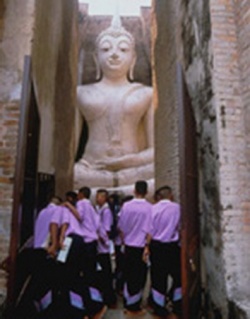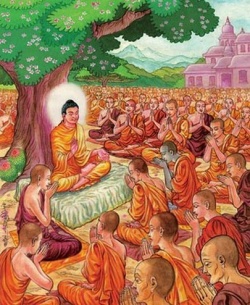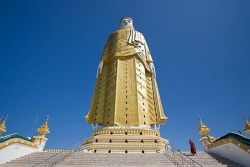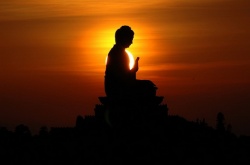Cakka-vatti
Click here to see other articles relating to word Cakka-vatti
Cakka-vatti
The special name given in the books to a World ruler. The world itself means "Turner of the Wheel," the Wheel (Cakka) being the well known Indian symbol of empire. There are certain stock epithets used to describe a Cakka-vatti:
dhammiko, dhammarājā, cāturanto (ruler of the four quarters),
vijitāvī (conqueror),
janapadatthavāriyappatto (guardian of the people's good), and
sattaratanasamannāgato (possessor of the Seven Treasures).
More than one thousand sons are his; his dominions extend throughout the earth to its ocean bounds (sāgarapariyantam); and is established not by the scourge, nor by the sword, but by righteousness (adandena asatthena dhammen'eva abhivijiva). Particulars are found chiefly in the Mahāsudassana, Mahāpadāna, Cakkavattisīhanāda, Bālapandita and Ambattha Sutta's. See also S.v.98.
From the Mahāpadāna Sutta it would appear that the birth of a Cakka-vatti is attended by the same miracles as that of the birth of a Buddha. A Cakka-vatti's youth is the same as that of Buddha; he, too, possesses on his body the Mahāpurisalakkhanāni, and sooth-sayers are able to predict at the child's birth only that one of two destinies await him.
Of the Seven Treasures of a Cakka-vatti, the Cakkaratana is the chief. When he has traversed the Four Continents:
Pubbavideha
Jambudīpa
Aparagoyāna
Uttarakuru
accompanied by the Cakkaratana, received the allegiance of all the inhabitants and admonished them to lead the righteous life, he returns to his own native city.
After the Wheel, other Treasures make their appearance:
first the Elephant, Hatthiratana; it is either the youngest of the Chaddanta-kula or the oldest of the Uposatha-kula.
Next the Horse, Assaratana, named Valāhaka, all white with crow black head, and dark mane, able to fly through the air.
Then the Veluriya-gem from Vepullapabbata, with eight facets, the finest of its species, shedding light for a league around.
This is followed by the Woman, belonging either to the royal family of Madda or of Uttarakuru, desirable in every way, both because of her physical beauty and her virtuous character.
Then the Treasurer (Gahapati) possessed of marvellous vision, enabling him to discover treasures,
and then the Adviser (Parināyaka), who is generally the Cakka-vatti's eldest son.
Judging from the story of Mahāsudassana, who is the typical Cakka-vatti, the World emperor has also four other gifts (iddhi):
a marvellous figure,
a life longer than that of other men, good health,
and popularity with all classes of his subjects.
The perfume of sandalwood issues from his mouth, while his body is like a lily.
When the Cakka-vatti is about to die the Wheel slips down from its place and sinks down slightly. When the king sees this he leaves the household life, and retires into homelessness, to taste the joys of contemplation, having handed over the kingdom to his eldest son. At the king's death, the Elephant, the Horse and the Gem return to where they came from, the Woman loses her beauty, the Treasurer his divine vision, and the Adviser his efficiency (DA.ii.635).
Cakka-vattis are rare in the world, and are born in kappas in which Buddhas do not arise (SA.iii.131). The Cakkavattisīhanāda Sutta, however, gives the names of seven who succeeded one another. In the case of each of them the Wheel disappeared, but, when his successor practised the Ariyan duty of a Cakka-vatti, honoring the Dhamma and following it to perfection, the Wheel re-appeared. In the case of the seventh his virtues gradually disappeared through forgetfulness; crime spread, among his subjects, and the Wheel vanished for ever.
In the earlier literature the term Cakka-vatti seems to have been reserved for a World ruler; but later three sorts of Cakka-vattis are mentioned:
cakkavāla- or cāturanta-cakkavatti (ruling over the four continents),
dīpa-cakkavatti (ruling over one), and
padesacakkavatti (over part of one). (DA.i.249)
No woman can become a Cakka-vatti (the reasons for this are given at AA.i.254).
A Cakka-vatti is, as worthy of a thūpa as a Buddha. D.ii.143."
[Quelle: Malalasekera, G. P. <1899 - 1973>: Dictionary of Pāli proper names. -- Nachdruck der Ausgabe 1938. -- London : Pali Text Society, 1974. -- 2 vol. -- 1163, 1370 S. -- ISBN 0860132692. -- s. v.]



